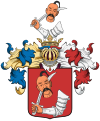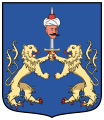Hungarian heraldry
The Hungarian Heraldry based more or less on the basis of German heraldry . This variety of medieval elements was adopted into Hungarian heraldry and survived in Hungary for a long time . This type of heraldry lasted longer than the Roman-German Empire. So you can often find castles , defense towers and city walls. Austrian heraldry also had a further influence : the temporary affiliation with the Habsburg dynasty was also reflected in Hungarian heraldry. The creepy-looking heraldic peculiarities arose especially in the time of the Turkish wars . In the coats of arms there are cut or bleeding Turkish heads. These were shown in the shield with and without a turban or pagan hats . The Turkish-Ottoman headgear was also shown impaled on lances or sabers. On helmets you can find stinging and bow helmets - almost all with helmet crowns - on the signs. Multi-colored helmet covers in blue-gold and red-silver are predominant. Sword-wielding armored arms and sword-wielding lions , but also only Turkish sabers, are often seen on Hungarian coats of arms, as well as the griffin as a heraldic animal . Popular motifs also include images of riding pandours and hussars . The Hungarian nobility also liked to fall back on Magyar tribal symbols: these are mythical animals , sun , moon and stars . Simple herald images are not very common in Hungarian heraldry.
Examples of cut off or bleeding Turkish heads in Hungarian heraldry.
Impaled Turkish head in the shield and Komádi coat of arms
literature
- A. Nyarys: Heraldica Vezérfonala . Budapest 1886.
- Walter Leonhard : The great book of heraldic art . Georg DWCallwey, Munich 2001, ISBN 3-8289-0768-7 .
- Milan boys : heraldry . Albatros, Prague 1987.
- Gert Oswald : Lexicon of Heraldry . VEB Bibliographisches Institut, Leipzig 1984.


